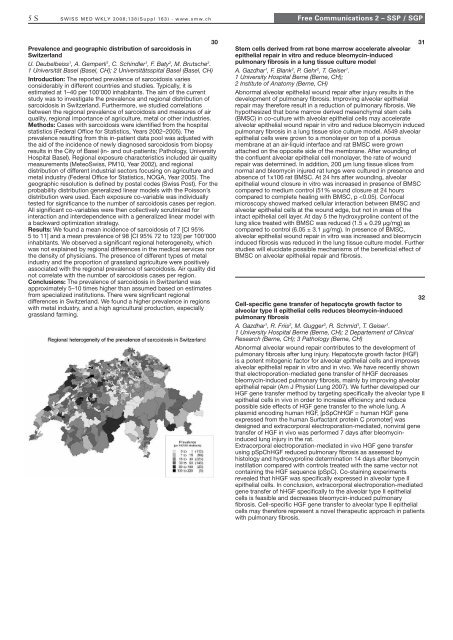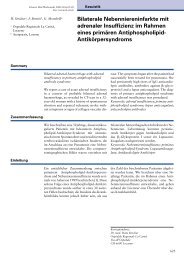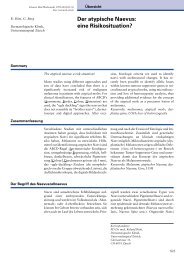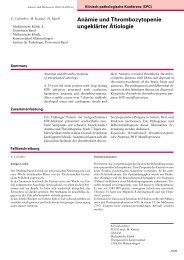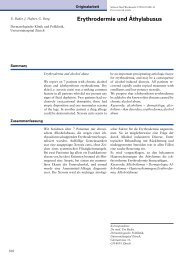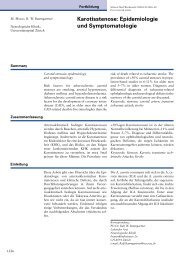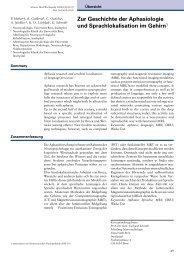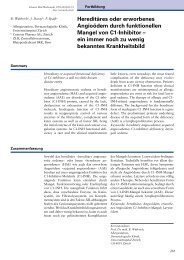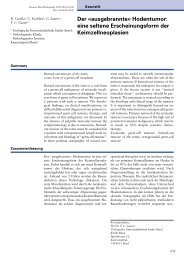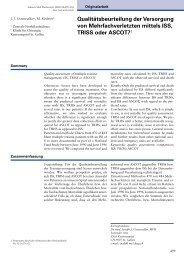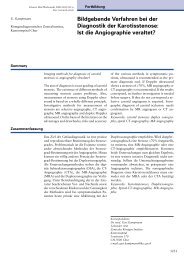Supplementum 163 - Swiss Medical Weekly
Supplementum 163 - Swiss Medical Weekly
Supplementum 163 - Swiss Medical Weekly
Create successful ePaper yourself
Turn your PDF publications into a flip-book with our unique Google optimized e-Paper software.
5S SWISS MED WKLY 2008;138(Suppl <strong>163</strong>) · www.smw.ch<br />
Free Communications 2 – SSP / SGP<br />
30<br />
Prevalence and geographic distribution of sarcoidosis in<br />
Switzerland<br />
U. Deubelbeiss1 , A. Gemperli1 , C. Schindler1 , F. Baty2 , M. Brutsche2 .<br />
1 Universität Basel (Basel, CH); 2 Universitätsspital Basel (Basel, CH)<br />
Introduction: The reported prevalence of sarcoidosis varies<br />
considerably in different countries and studies. Typically, it is<br />
estimated at 1–40 per 100’000 inhabitants. The aim of the current<br />
study was to investigate the prevalence and regional distribution of<br />
sarcoidosis in Switzerland. Furthermore, we studied correlations<br />
between the regional prevalence of sarcoidosis and measures of air<br />
quality, regional importance of agriculture, metal or other industries.<br />
Methods: Cases with sarcoidosis were identified from the hospital<br />
statistics (Federal Office for Statistics, Years 2002–2005). The<br />
prevalence resulting from this in-patient data pool was adjusted with<br />
the aid of the incidence of newly diagnosed sarcoidosis from biopsy<br />
results in the City of Basel (in- and out-patients; Pathology, University<br />
Hospital Basel). Regional exposure characteristics included air quality<br />
measurements (Meteo<strong>Swiss</strong>, PM10, Year 2002), and regional<br />
distribution of different industrial sectors focusing on agriculture and<br />
metal industry (Federal Office for Statistics, NOGA, Year 2005). The<br />
geographic resolution is defined by postal codes (<strong>Swiss</strong> Post). For the<br />
probability distribution generalized linear models with the Poisson’s<br />
distribution were used. Each exposure co-variable was individually<br />
tested for significance to the number of sarcoidosis cases per region.<br />
All significant co-variables were then collectively scrutinized for<br />
interaction and interdependence with a generalized linear model with<br />
a backward optimization strategy.<br />
Results: We found a mean incidence of sarcoidosis of 7 [CI 95%<br />
5 to 11] and a mean prevalence of 98 [CI 95% 72 to 123] per 100’000<br />
inhabitants. We observed a significant regional heterogeneity, which<br />
was not explained by regional differences in the medical services nor<br />
the density of physicians. The presence of different types of metal<br />
industry and the proportion of grassland agriculture were positively<br />
associated with the regional prevalence of sarcoidosis. Air quality did<br />
not correlate with the number of sarcoidosis cases per region.<br />
Conclusions: The prevalence of sarcoidosis in Switzerland was<br />
approximately 5–10 times higher than assumed based on estimates<br />
from specialized institutions. There were significant regional<br />
differences in Switzerland. We found a higher prevalence in regions<br />
with metal industry, and a high agricultural production, especially<br />
grassland farming.<br />
31<br />
Stem cells derived from rat bone marrow accelerate alveolar<br />
epithelial repair in vitro and reduce bleomycin-induced<br />
pulmonary fibrosis in a lung tissue culture model<br />
A. Gazdhar1 , F. Blank2 , P. Gehr2 , T. Geiser1 .<br />
1 University Hospital Berne (Berne, CH);<br />
2 Institute of Anatomy (Berne, CH)<br />
Abnormal alveolar epithelial wound repair after injury results in the<br />
development of pulmonary fibrosis. Improving alveolar epithelial<br />
repair may therefore result in a reduction of pulmonary fibrosis. We<br />
hypothesized that bone marrow derived mesenchymal stem cells<br />
(BMSC) in co-culture with alveolar epithelial cells may accelerate<br />
alveolar epithelial wound repair in vitro and reduce bleomycin induced<br />
pulmonary fibrosis in a lung tissue slice culture model. A549 alveolar<br />
epithelial cells were grown to a monolayer on top of a porous<br />
membrane at an air-liquid interface and rat BMSC were grown<br />
attached on the opposite side of the membrane. After wounding of<br />
the confluent alveolar epithelial cell monolayer, the rate of wound<br />
repair was determined. In addition, 200 µm lung tissue slices from<br />
normal and bleomycin injured rat lungs were cultured in presence and<br />
absence of 1x106 rat BMSC. At 24 hrs after wounding, alveolar<br />
epithelial wound closure in vitro was increased in presence of BMSC<br />
compared to medium control (51% wound closure at 24 hours<br />
compared to complete healing with BMSC, p


